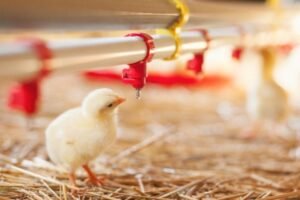Vaccine Failure in Poultry: Causes and Treatments
Dr. Majid Al-Sayegh, Professor of Poultry Diseases and Vaccines
29/ 8/ 2025

Introduction
Vaccination is one of the most cost-effective tools for protecting poultry flocks from major infectious diseases. Viral diseases such as Newcastle disease (ND), avian influenza (AI), Gumboro disease/bursitis of Fabricius (IBD), and infectious bronchitis (IB) are major causes of mortality and economic losses in the poultry industry worldwide. In environments with limited veterinary infrastructure, these diseases remain a persistent threat, causing significant losses to producers. Routine vaccination of broiler and layer chickens with multiple vaccines has become standard practice to reduce these losses. However, vaccine failure can occur when vaccinated birds do not develop sufficient protective immunity and remain susceptible to disease outbreaks. Field infections in “vaccinated” flocks indicate a defect in the vaccination process. Understanding the causes of vaccine failure is critical for implementing prevention strategies. This review examines common factors leading to poultry vaccine failure and identifies methods for preventing or mitigating them, with updates through 2025.
Common Causes of Vaccine Failure in Poultry
Poor Vaccine Viability (Storage and Handling): The primary requirement for successful vaccination is an effective vaccine with sufficient viability. Live vaccines—and even killed vaccines—lose their effectiveness if not stored and handled properly. Most poultry vaccines must be kept refrigerated (2–8°C) and used before expiration. Interruptions in the cold chain—such as exposing vaccines to high temperatures or direct sunlight—cause antigen degradation. Studies have shown that cold chain disruptions lead to a significant percentage of doses being spoiled and increase the risk of vaccine failure and outbreaks. Live virus vaccines are highly sensitive to heat and can lose their potency rapidly. For example, a reconstituted live bronchitis vaccine can lose half its potency in less than an hour when warmed. Some vaccines can also be damaged by freezing (such as oil-based emulsified vaccines due to crystal formation). Using expired or ineffective vaccines due to poor storage (or contact with disinfectants in syringes/instruments) will often result in a failed immune response.
Vaccine strain/serotype mismatch with field isolates: Effective immunity requires antigenic matching with field isolates. If the circulating viruses/bacteria are sufficiently different (antigenic drift/shift, use of an inappropriate serotype), antibodies may not neutralize the field strain. This is seen in diseases such as bronchitis and avian influenza; flocks vaccinated against a particular strain may be infected with a variant strain. A common example: IB vaccines often contain the Massachusetts strain; if strains circulating from Arkansas or elsewhere are present, outbreaks may occur despite vaccination. Similarly, an inactivated AI vaccine formulated with an older strain may not protect against an emerging strain. In recent years, the emergence of highly pathogenic H5Nx and new NDV strains has necessitated regular updates of vaccine components. This necessitates continuous monitoring of field isolates and updating vaccines or using autogenous vaccines to match local strains.
Insufficient dose or inconsistent coverage: Even with a safe and appropriate vaccine, administration errors can lead to some birds not being immunized. Incorrect dilution or dose miscalculations (too much solvent, too little mixing, etc.) can reduce the actual dose per bird. When administering live vaccines via drinking water or spray, inconsistent distribution can lead to birds being missed or receiving insufficient doses. Relying on the spread of the vaccine from bird to bird is risky: some birds may not be vaccinated, while others may receive excessive doses with severe reactions. Injections can also miss a proportion of birds if the skill or organization is poor. Choosing the wrong route also undermines the response: Newcastle vaccine intended for ophthalmic drops does not work the same way if administered in chlorinated water, and a killed vaccine intended for intramuscular administration will fail if incorrectly administered subcutaneously. Adherence to the manufacturer’s instructions (dose/route/method) is crucial to ensure consistent immune stimulation.
Maternal Antibody Interference: Chicks acquire passive immunity from their mothers in the egg, protecting them early in life. However, high levels of maternal antibodies against a specific disease can neutralize a live vaccine given early, inhibiting its effectiveness. Chicks from well-immunized mothers against IBD may harbor potent antibodies for 2–3 weeks; if vaccinated during the first week, these antibodies may inactivate the vaccine before it can replicate. Therefore, the timing of the first dose is critical and must coincide with the waning of maternal immunity. Late or absent booster doses also create immunological gaps, especially if maternal immunity delays the initial response.
Bird Health and Immunological Status: Vaccination requires an immune system capable of responding. Stress is a major factor—birds stressed by heat/cold, overcrowding, malnutrition, or transport exhibit a weaker response. Likewise, immunosuppressive diseases or concurrent infections (IBD, Marek’s disease, infectious anemia, mycotoxins, etc.) weaken the immune organs (bursa and thymus) and reduce the effectiveness of vaccines. There are also genetic differences (MHC) that may make some breeds less responsive to certain vaccines. In short, the healthier the herd is at the time of vaccination, the greater the program’s chances of success.
Human errors in vaccination: Improperly dissolving or mixing vaccines (inappropriate diluent, water containing a disinfectant/antibiotic) can kill the live vaccine immediately. Live vaccines must be mixed with dechlorinated water and stabilizers such as skimmed milk powder to protect the virus. Live vaccines also lose potency rapidly after dissolution and must be administered within 1–2 hours. Delaying or using any leftovers the next day results in poor doses. Other technical errors include injecting into the feathers, choosing the wrong needle/position, not shaking oil-based vaccines regularly, etc. Vaccinating birds during the incubation period can also cause lesions to appear days later, and the vaccine is mistakenly considered a failure.
Scheduling and program errors: Program design requires an understanding of local infection pressures and the bird’s developmental stage. Administering vaccines at the wrong age (e.g., fowl pox too early) or during a stressful season (peak heat/production) reduces response. Furthermore, administering multiple vaccines simultaneously may cause interference (especially with similar vector vaccines) or increase cross-reactivity. Finally, high pathogenic pressure (poor biosecurity, multi-age population, high contamination residues in the shed) may overwhelm vaccine-induced immunity.

Vaccine Failure Prevention Strategies
Maintain vaccine quality and the cold chain: Store vaccines according to recommendations (usually 2–8°C), transport them in refrigerated boxes, avoid direct sunlight, and do not use expired or frozen vaccines without explicit instructions. Prepare everything in advance to minimize the time between opening the vial and administration. In resource-limited settings, prefer thermotolerant vaccines whenever possible (such as Newcastle strain I-2) and use stabilizers (sugars/skimmed milk ~ 2 g/L) to protect live vaccines in drinking water.
Select vaccines that match local strains: Update your program according to the epidemiology of the region. Identify circulating strains (IBV, NDV, HPAI, etc.) and include appropriate types/strains or auto-vaccines for local strains. Bivalent/polyvalent or recombinant vector vaccines may extend the protection spectrum, and their coverage of field isolates should be evaluated.
Adhere to a proper schedule and timing: Adjust the timing of the first doses according to the decline of maternal antibodies (based on ELISA or known curves). Adhere to the guidelines for booster doses to ensure sustained immunity, especially in chicks and layers before the start of production. Avoid vaccination during times of high stress, preferring early morning or cool evening.
Proper administration techniques: Train teams on proper thawing, dosing, and route.
Drinking water: Withhold water for a short period before vaccination. Use dechlorinated water with a stabilizer. Clean the drinkers. Distribute the vaccine evenly so it is consumed within 1–2 hours.
Spray: Adjust the droplet size and achieve uniform coverage.
Individual doses (ophthalmic/nasal instillation, wing membrane pricking, injection): Inject at the appropriate site and depth, ensuring the droplet is inserted and the eye is “winked”/inhaled. Shake oil-based vaccines during use. Document everything (batch/expiry date/administrator/incidents).
Preparing birds’ health and environment before vaccination: Reduce stress before/after vaccination, improve ventilation and house temperature, and provide balanced nutrition and adequate water. Vitamins and electrolytes (A, D, E, C, and B complex) can support the immune response and mitigate the effects of stress; studies have shown increased antibody titers after NDV/IBV with appropriate nutritional support. Address immunosuppressive problems (IBD, mycotoxins, etc.) in advance. Use antibiotics prophylactically with caution and only under veterinary supervision when necessary.
Follow the manufacturer’s instructions: Read the label and follow the recommended dose/route/solution. Do not mix different vaccines in one syringe/solution unless authorized. Do not “dilute” vials with additional dilutions. Dissolve only the amount that can be used during the stability window (usually <2 hours). Adhere to revaccination programs and note subsequent appointments.
Enhancing biosecurity and reducing infection pressure: Vaccination is not an absolute shield; Massive exposure can overcome immunity. Implement strict biosecurity measures: control human movement, disinfect equipment, isolate new birds, control rodents and wild birds, and adopt a total entry/total exit system whenever possible. Clean houses between cycles and manage litter effectively. Avoid age mixing or at least separate vaccinated young birds from potentially carrier adults. In high-risk areas (vvND, HPAI), use sentinel birds and serological surveillance to ensure the program’s effectiveness.
Monitoring and Evaluation: Perform periodic serological tests (ELISA/HI) after 2–3 weeks to ensure that titers have reached protective levels. If they are low, investigate the cause and adjust the program or revaccinate before an outbreak occurs. Maintain accurate disease and vaccination records to continually improve the program.
Conclusion
Vaccine failure in poultry can be minimized by addressing the factors influencing the immune response: vaccine quality and cold chain, matching with field strains, administration technique and dosage, timing of vaccination relative to maternal immunity, health status and stress reduction, and strict adherence to biosecurity. When these principles are respected, the chances of successful vaccination programs increase and flock health and productivity improve. Looking ahead, vaccine developments are bringing additional solutions: heat-tolerant vaccines that circumvent cold chain restrictions, innovative delivery methods (spray/oral), better adjuvants, recombinant/vector vaccines, or even messenger RNA (mRNA) technologies—all aimed at broader and longer-lasting protection. By combining these innovations with breeder training and veterinary support, vaccine failure can be made a rare occurrence.



